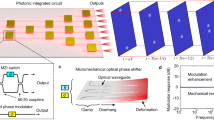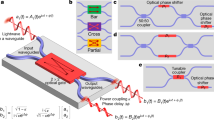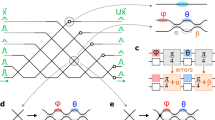Abstract
Programmable photonic integrated circuits (PICs) are dense assemblies of tunable elements that provide flexible reconfigurability to enable different functions to be selected; however, due to manufacturing variations and thermal gradients that affect the optical phases of the elements, it is difficult to guarantee a stable correspondence between the electrical commands to the chip, and the function that it provides. Here we demonstrate a self-calibrating programmable PIC with full control over its complex impulse response, in the presence of thermal cross-talk between phase-tuning elements. Self-calibration is achieved by: (1) incorporating an optical reference path into the PIC; (2) using the Kramers–Kronig relationship to recover the phase response from amplitude measurements; and (3) applying a fast-converging self-calibration algorithm. We demonstrate dial-up signal processing functions with complex impulse responses using only 25 training iterations. This approach offers stable and accurate control of large-scale PICs, for demanding applications such as communications network reconfiguration, neuromorphic hardware accelerators and quantum computers.
This is a preview of subscription content, access via your institution
Access options
Access Nature and 54 other Nature Portfolio journals
Get Nature+, our best-value online-access subscription
$29.99 / 30 days
cancel any time
Subscribe to this journal
Receive 12 print issues and online access
$209.00 per year
only $17.42 per issue
Buy this article
- Purchase on Springer Link
- Instant access to full article PDF
Prices may be subject to local taxes which are calculated during checkout





Similar content being viewed by others
Data availability
The authors declare that the data supporting the findings of this study are available within the paper and its Supplementary Information.
Code availability
The authors declare that the algorithm supporting the findings of this study are available within the paper and its Supplementary Information.
References
Chrostowski, L. & Hochberg, M. Silicon Photonics Design (Cambridge Univ. Press, 2015).
Lin, Y. et al. Characterization of hybrid InP-TriPleX photonic integrated tunable lasers based on silicon nitride (Si3N4/SiO2) microring resonators for optical coherent system. IEEE Photon. J. 10, 1400108 (2018).
Bogaerts, W. et al. Integrated Design for Integrated Photonics: from the Physical to the Circuit Level and Back. In Proc. SPIE 8781, Integrated Optics: Physics and Simulations 878102 (SPIE, 2013).
Inniss, D. & Rubenstein, R. Silicon Photonics: Fueling the Next Information Revolution (Elsevier, 2016).
Streshinsky, M. et al. The road to affordable, large-scale silicon photonics. Opt. Photon. News 24, 32–39 (2013).
Carrol, L. et al. Photonic packaging: Transforming silicon photonic integrated circuits into photonic devices. Appl. Sci. 6, 426 (2016).
Capmany, J. & Pérez, D. Programmable Integrated Photonics (Oxford Univ. Press, 2019).
Lyke, J. et al. An introduction to reconfigurable systems. Proc. IEEE 103, 291–317 (2015).
Capmany, J., Gasulla, I. & Pérez, D. The programmable processor. Nat. Photon. 10, 6–8 (2015).
Bogaerts, W. et al. Programmable photonic circuits. Nature 586, 207–216 (2020).
Zhuang, L. et al. Programmable photonic signal processor chip for radiofrequency applications. Optica 2, 854–859 (2015).
Zheng, D. et al. Low-loss broadband 5 × 5 non-blocking Si3N4 optical switch matrix. Opt. Lett. 44, 2629–2632 (2019).
Zhang, W. & Yao, J. Photonic integrated field-programmable disk array signal processor. Nat. Commun. 11, 406 (2020).
Pérez, D. & Capmany, J. Scalable analysis for arbitrary photonic integrated waveguide meshes. Optica 6, 19–27 (2019).
Pérez, D., Gasulla, I. & Capmany, J. Field-programmable photonic arrays. Opt. Express 26, 27265–27278 (2018).
Pérez, D. et al. Multipurpose silicon photonics signal processor core. Nat. Commun. 8, 636 (2017).
Ribeiro, A. et al. Demonstration of a 4 × 4-port universal linear circuit. Optica 3, 1348–1357 (2016).
Annoni, A. Unscrambling light—automatically undoing strong mixing between modes. Light: Sci. Appl. 6, e17110 (2017).
Carolan, J. et al. Universal linear optics. Science 349, 711 (2015).
Shen, Y. et al. Deep learning with coherent nanophotonic circuits. Nat. Photon. 11, 441–446 (2017).
Miller, D. A. B. Perfect optics with imperfect components. Optica 2, 747–750 (2015).
Milanizadeh, M. et al. Cancelling thermal cross-talk effects in photonic integrated circuits. J. Light. Tech. 37, 1325–1332 (2019).
Pérez-López, D. et al. Multipurpose self-configuration of programmable photonic circuits. Nat. Commun. 11, 6359 (2020).
Yegnanarayanan, S. et al. Automated initialization of reconfigurable silicon nitride (SiNx) filters. In Conference on Lasers and Electro-Optics (IEEE, 2018).
Tait, A. N. et al. Continuous calibration of microring weights for analog optical networks. IEEE Photon. Technol. Lett. 28, 887–890 (2016).
Tait, A. N. et al. Multi-channel control for microring weightbanks. Opt. Express 24, 8895 (2016).
Jiang, H. et al. Chip-based arbitrary radio-frequency photonic filter with algorithm-driven reconfigurable resolution. Opt. Lett. 43, 415–418 (2018).
Jayatilleka, H. Automatic configuration and wavelength locking of coupled silicon ring resonators. J. Lightwave Technol. 36, 210–218 (2018).
Choo, G. Automatic monitor-based tuning of reconfigurable silicon photonic APF-based pole/zero filters. J. Lightwave Technol. 36, 1899–1911 (2018).
Choo, G. Automatic monitor-based tuning of an RF silicon photonic 1 × 4 asymmetric binary tree true-time-delay beamforming network. J. Lightwave Technol. 36, 5263–5275 (2018).
Gazman, A. et al. Tapless and topology agnostic calibration solution for silicon photonic switches. Opt. Express 26, 347241 (2018).
Cheng, Q. et al. First demonstration of automated control and assessment of a dynamically reconfigured monolithic 8 × 8 wavelength-and-space switch. IEEE J. Opt. Commun. Netw. 7, 388–395 (2015).
Carolan, J. et al. Scalable feedback control of single photon sources for photonic quantum technologies. Optica 6, 335–341 (2019).
Guan, B. et al. CMOS compatible reconfigurable silicon photonic lattice filters using cascaded unit cells for RF-photonic processing. IEEE J. Sel. Top. Quantum Electron. 20, 359–368 (2014).
Zhang, H. et al. An optical neural chip for implementing complex-valued neural network. Nat. Commun. 12, 457 (2021).
Hayes, M., Lim, J. S. & Oppenheim, A. V. Signal reconstruction from phase or magnitude. IEEE Trans. Acoust. Speech Signal Process. 28, 672–680 (1980).
Ozcan, A., Digonnet, M. J. F. & Kino, G. S. Minimum-phase-function-based processing in frequency-domain optical coherence tomography systems. J. Opt. Soc. Am. A 23, 1669–1677 (2006).
Ozcan, A., Digonnet, M. J. F. & Kino, G. S. Characterization of Fiber Bragg gratings using spectral interferometry based on minimum-phase functions. J. Lightwave Technol. 24, 1739 (2006).
Mecozzi, A., Antonelli, C. & Shtaif, M. Kramers–Kronig coherent receiver. Optica 3, 1220–1227 (2016).
Halir, R. et al. Characterization of integrated photonic devices with minimum phase technique. Opt. Express 17, 8349–8361 (2009).
Li, Z. et al. SSBI mitigation and the Kramers–Kronig scheme in single-sideband direct-detection transmission with receiver-based electronic dispersion compensation. J. Lightwave Technol. 35, 1887–1893 (2017).
Xie, Y., Zhuang, L. & Lowery, A. J. Picosecond optical pulse processing using a terahertz-bandwidth reconfigurable photonic integrated circuit. Nanophotonics 7, 837–852 (2018).
Zhuang, L. et al. Novel microwave photonic fractional Hilbert transformer using a ring resonator-based optical all-pass filter. Opt. Express 20, 26499–26510 (2012).
Guo, Y., Jafari, Z., Agarwal, A. M., Kimerling, L. C., Li, G., Michel, J. & Zhang, L. Bilayer dispersion-flattened waveguides with four zero-dispersion wavelengths. Opt. Lett. 41, 4939–4942 (2016).
Roeloffzen, C. G. H. et al. Silicon nitride microwave photonic circuits. Opt. Express 21, 22937–22961 (2013).
Wörhoff, K., Heideman, R. G., Leinse, A. & Hoekman, M. Triplex: a versatile dielectric photonic platform. Adv. Opt. Technol. 4, 189–207. (2015).
Qiao, P., Cook, K. T., Li, K. & Chang-Hasnain, C. J. Wavelength-swept VCSELs. In IEEE J. Sel. Top. Quantum Electron. 23, 1700516 (2017).
Mauthe, S. et al. High-speed III–V nanowire photodetector monolithically integrated on Si. Nat. Commun. 11, 4565 (2020).
Acknowledgements
We thank L. Zhuang, Y. Xie and S. Schoenhardt for the layout and tests of the FIR chip in prior projects. We thank B. Corcoran for the discussion of experiments. We thank A. Linzner for the fabrication of metal chip holders. We thank LioniX International, the Netherlands, for fabricating the FIR chip. This work was supported by the Australian Research Council Discovery Projects Program (grant no. DP190101576, DP190102773).
Author information
Authors and Affiliations
Contributions
X.X., A.J.L. and A.B. conceived the idea and designed the project. X.X. performed the numerical simulations and experiments. G.R., A.B. and T.F. prepared experimental hardware. X.X., A.J.L., A.B., G.R., X.L. and A.M. contributed to the development of the experiment and to the data analysis. X.X. and A.J.L. wrote the manuscript with inputs from all other authors. A.J.L. and A.B. supervised the research.
Corresponding author
Ethics declarations
Competing interests
The authors declare no competing interests.
Peer review
Peer review information
Nature Photonics thanks Daniel Perez-Lopez and the other, anonymous, reviewer(s) for their contribution to the peer review of this work.
Additional information
Publisher’s note Springer Nature remains neutral with regard to jurisdictional claims in published maps and institutional affiliations.
Supplementary information
Supplementary Information
Supplementary Discussion and Figs. 1–12.
Rights and permissions
About this article
Cite this article
Xu, X., Ren, G., Feleppa, T. et al. Self-calibrating programmable photonic integrated circuits. Nat. Photon. 16, 595–602 (2022). https://doi.org/10.1038/s41566-022-01020-z
Received:
Accepted:
Published:
Issue Date:
DOI: https://doi.org/10.1038/s41566-022-01020-z
This article is cited by
-
Deep photonic network platform enabling arbitrary and broadband optical functionality
Nature Communications (2024)
-
General-purpose programmable photonic processor for advanced radiofrequency applications
Nature Communications (2024)
-
Active mid-infrared ring resonators
Nature Communications (2024)
-
Photogating-assisted tunneling boosts the responsivity and speed of heterogeneous WSe2/Ta2NiSe5 photodetectors
Nature Communications (2024)
-
Chip-to-chip optical multimode communication with universal mode processors
PhotoniX (2023)



